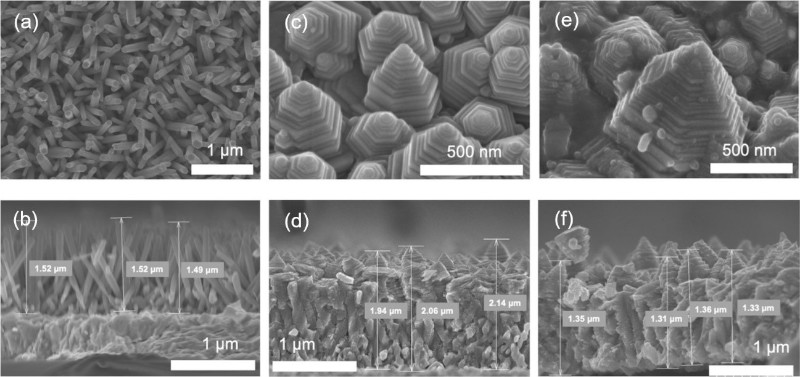

Development of zinc oxide nanopagoda array photoelectrode
Toward photoelectrochemical water-splitting hydrogen production Go Kawamura
A research team consisting of members of the Egyptian Petroleum Research Institute and the Functional Materials Science Laboratory at the Toyohashi University of Technology, has developed a novel high-performance photoelectrode by constructing a zinc oxide nanopagoda array with a unique shape on a transparent electrode and applying silver nanoparticles to its surface. The zinc oxide nanopagoda is characterized by having many step structures, as it comprises stacks of differently sized hexagonal prisms. In addition, it exhibits very few crystal defects and excellent electron conductivity. By decorating its surface with silver nanoparticles, the zinc oxide nanopagoda array photoelectrode gains visible light absorption properties, enabling it to function under sunlight irradiation.
Photoelectrochemical water splitting using sunlight is expected to be used as a technology to produce clean energy in the form of hydrogen. As key materials for this technology, photoelectrodes must have low overpotential against water splitting reactions, in addition to high solar absorption and charge transfer efficiencies. For practical applicability, this technology cannot use rare metals as primary materials, and the fabrication process must be industrialized; however, materials that satisfy these requirements have not yet been developed.
Accordingly, the research team solely focused on the zinc oxide nanopagoda array, as such arrays are inexpensive to produce, feature high electron conductivity, and are not vulnerable to raw material depletion. Initially, zinc oxide nanopagoda arrays were considered difficult to fabricate with good reproducibility. Led by Marwa Abouelela – a third-year doctoral student who is also the lead author of this paper - the team first optimized the synthesis process to ensure high reproducibility. When the photoelectrochemical properties of the obtained photoelectrode were evaluated, a relatively large photocurrent was observed to emerge under pseudo-sunlight irradiation. In addition to the high charge transfer efficiency associated with low defect density and high surface chemical reaction activity due to its many steps, an electromagnetic field analysis has revealed that the nanopagoda's unique nanostructure can efficiently capture ultraviolet rays contained in the incident light.
To ensure the effective utilization of visible light, which accounts for 55% of sunlight, the research team further improved the photoelectrochemical properties by decorating the zinc oxide nanopagoda surface with silver nanoparticles that exhibit localized surface plasmon resonance, increasing the photocurrent by approximately 1.5-fold. The action spectrum of the photocurrent value indicates that this improvement is primarily attributed to the hot electron transfer caused by visible light absorption by the localized surface plasmon resonance of silver nanoparticles. By optimizing the application of silver nanoparticles, it became possible to improve the photoelectrochemical properties without producing adverse effects on the properties of the nanopagoda itself.
Associate Professor Go Kawamura, one of the corresponding authors, stated the following: “Zinc oxide nanopagodas were previously only considered suitable for use in electron gun emitters, which made the most of their high charge transfer efficiency. However, because the structure has many steps, our initial idea was that it suitable for photoelectrochemical reactions due to its high activity for surface chemical reactions. After successfully fabricating the nanopagodas, we modified them with silver nanoparticles that exhibit surface plasmon resonance in order to improve the efficiency of sunlight utilization, and evaluated the effect of the modification by electromagnetic field analysis..What we found however, was that the zinc oxide nanopagoda has the property of absorbing incident light, especially ultraviolet rays, into the zinc oxide. This was a completely unexpected, but fortuitous discovery, as this property contributes to the improved photoelectrochemical properties.”
Currently, Marwa and students of the same laboratory are investigating the effects of precise structural control of zinc oxide nanopagodas, as well as surface decoration with other materials, on their photoelectrochemical properties. Since zinc oxide is prone to photocorrosion due to its inability to withstand long-term sunlight irradiation, improving its durability via surface decoration is a major current theme. Upon achieving both high photoelectrochemical properties and durability, we plan to carry out water splitting hydrogen production in a real environment (decomposition of river water or seawater by sunlight) to extract real issues.
This research was supported by JSPS Grants-in-Aid for Scientific Research 21K18823, 21K18824, and 22K04737, the Casio Science Promotion Foundation, the ENEOS TonenGeneral Research/Development Encouragement & Scholarship Foundation, and the Ministry of Higher Education of the Arab Republic of Egypt PD-071.

(a)(b): zinc oxide nanorod array, (c)(d): zinc oxide nanopagoda array, (e)(f): silver-nanoparticle-decorated zinc oxide nanopagoda array. The upper row includes surface images, and the lower row includes corresponding cross-sectional images.
Reference
Abouelela MM, Kawamura G, Tan WK, Amiruldin M, Maegawa K, Nishida J, Matsuda A (2024) Ag nanoparticles decorated ZnO nanopagodas for photoelectrochemical application. Electrochemistry Communications,158, 107645, 10.1016/j.elecom.2023.107645
酸化亜鉛ナノパゴダアレイ光電極の開発
光電気化学的水分解水素製造に向けて 河村 剛豊橋技術科学大学 機能性材料科学研究室とエジプト石油研究所の研究チームは、ユニークな形態を有する酸化亜鉛ナノパゴダアレイを透明電極上に形成し、さらにその表面に銀ナノ粒子を修飾することで、新規な高機能光電極を開発しました。酸化亜鉛ナノパゴダは、サイズの異なる六角柱が積み重なった形状であり、多くのステップ構造を有することが特徴です。また、結晶欠陥が極めて少なく、電子伝導性に優れています。酸化亜鉛ナノパゴダアレイ光電極に銀ナノ粒子を修飾することで、可視光吸収特性が付与され、太陽光照射下で機能する光電極としての利用を可能とします。
クリーンなエネルギーである水素を製造する技術の1つとして、太陽光を利用した光電気化学的水分解の活用が期待されています。この技術のキーマテリアルである光電極には、高い太陽光吸収効率や電荷の移動効率に加えて、水分解反応に対する低い過電圧を有することなどが求められます。また、主となる素材にレアアースやレアメタルを使用しないことや、作製プロセスが産業化に適していることなども実用上重要になってきますが、それらすべての要求を満足する材料は開発されていません。
そこで研究チームは、原料枯渇の心配がない、価格が安価、高い電子伝導性を有するなどの特徴を持つ酸化亜鉛ナノパゴダアレイに注目しました。酸化亜鉛ナノパゴダアレイは、そもそも再現性良く作製することが困難とされていたため、筆頭著者である博士後期課程3年のMarwa Abouelelaを中心に、まずはその合成プロセスを最適化し、高い再現性の確保を実現しました。得られた光電極の光電気化学特性を評価したところ、疑似太陽光照射下で比較的大きな光電流が得られるとわかりました。これは、低欠陥量に伴う高い電荷移動効率と、多くのステップにおける高い表面化学反応活性に加えて、ナノパゴダの特異なナノ構造が入射光に含まれる紫外線を効率的に取り込むことができるということが電磁界解析等から明らかとなりました。
さらに研究チームは、太陽光の55%を占める可視光の有効利用に向けて、表面プラズモン共鳴を示す銀ナノ粒子を、酸化亜鉛ナノパゴダ表面に修飾することで、光電気化学特性の一層の向上を試みたところ、銀ナノ粒子修飾前に比べて約1.5倍の光電流が得られるとわかりました。光電流値の作用スペクトルから、この光電気化学特性の向上が、主に銀ナノ粒子の表面プラズモン共鳴による可視光吸収によって引き起こされる熱電子移動に帰属するものであることがわかりました。銀ナノ粒子の修飾方法を最適化することで、酸化亜鉛ナノパゴダ自体の特性への悪影響をなくして、光電気化学特性のみを向上できることもわかりました。
責任著者の一人である河村剛准教授は、以下のように言います。「当初、酸化亜鉛ナノパゴダは、その高い電荷移動効率を利用した電子銃エミッターへの応用のみが検討されていました。ただ、その構造が多くのステップを有していることから、表面化学反応に対する活性が高く、光電気化学反応を起こすのに適しているのではないか、というのが最初のアイデアでした。実際にナノパゴダの作製に成功した後、太陽光利用効率を向上するために、表面プラズモン共鳴を示す銀ナノ粒子を修飾し、その効果を電磁界解析によって評価したのですが、その際に酸化亜鉛ナノパゴダには、入射光、特に紫外線を酸化亜鉛の内部に取り込む特性があることがわかりました。これは全く想定していなかったものでしたが、光電気化学特性の向上に寄与する特性であり、幸運な発見でした。」
現在Marwaと同研究室の学生が中心となり、酸化亜鉛ナノパゴダの精密構造制御や、銀ナノ粒子以外の物質による表面修飾を行うことで、光電気化学特性にどのような影響があるかを調べています。酸化亜鉛は光溶解性のために、単体では長時間の太陽光照射に耐えられないため、表面修飾による耐久性の向上が現在の主なテーマとなっています。高い光電気化学特性と耐久性の両立が実現できた際には、実環境(太陽光による河川水や海水の分解)における水分解水素製造を行い、実課題の抽出をする予定です。
本研究はJSPS科研費21K18823、21K18824、22K04737、及び、カシオ科学振興財団、ENEOS東燃ゼネラル研究奨励・奨学会の助成を受けたものです。
Researcher Profile

| Name | Go Kawamura |
|---|---|
| Affiliation | Department of Electrical and Electronic Information Engineering |
| Title | Associate Professor |
| Fields of Research | Nanomaterials Science |
